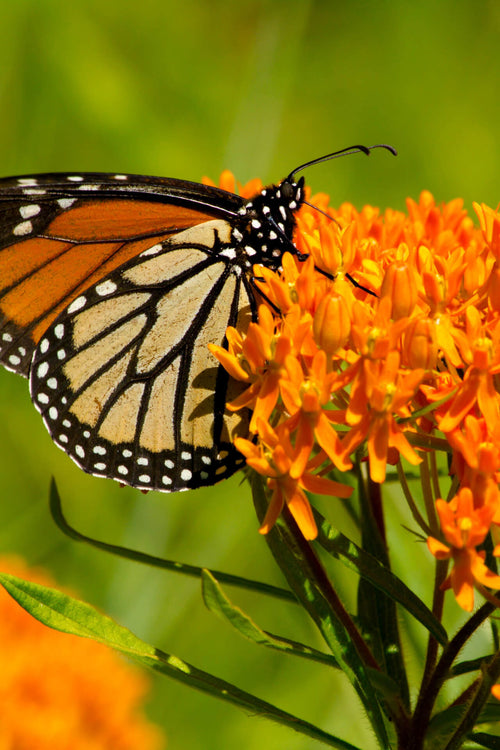Flowers for Bees and Butterflies: Nurturing Biodiversity and Beauty
In the realm of nature's intricate web, the delicate dance between flowers, bees, and butterflies stands as a testament to the symbiotic relationships that sustain our ecosystems. These remarkable pollinators, with their enchanting flights and vibrant hues, are captivating to observe and play a critical role in maintaining biodiversity and ensuring the reproduction of many plant species. The purple coneflower, milkweed, and bee balm stand out as beacons of sustenance and shelter among the myriad blossoms that beckon to these winged visitors.
Purple Coneflower (Echinacea purpurea):
Celebrating Resilience and Elegance The purple coneflower, with its striking magenta petals and dark, cone-shaped centers, is a familiar and beloved sight in gardens and natural landscapes. Native to North America, this perennial flowering plant embodies a blend of resilience and elegance that captures the essence of its environment. Beyond its aesthetic allure, the purple coneflower is a prime example of a nectar-rich haven for bees and butterflies. Bees, primarily attracted by the flower's abundant nectar reserves, are drawn to the coneflower's open, daisy-like blooms. As they extract nectar for their sustenance, they facilitate cross-pollination and the reproduction of the plants. These industrious insects are vital to the continuation of many plant species, as one-third of global food production relies on pollinators like bees. Butterflies, too, are lured by the coneflower's bountiful nectar and vibrant colors. They flit gracefully from petal to petal, their delicate wings brushing against the pollen-laden stamens and stigma, enabling fertilization and the subsequent production of seeds. In this symphony of nature, the purple coneflower is both a nourishing oasis and a vital link in the chain of life.
Milkweed (Asclepias spp.):
Monarchs and the Miraculous Migration Milkweed, often called the "nectar of the gods," holds a special place in the hearts of monarch butterflies and conservationists. This group of flowering plants encompasses various species, each uniquely adapted to different habitats across North America. Their significance lies in their role as a nectar source and host plant for monarch butterfly larvae. The monarch butterfly with its distinctive orange and black wings, undertakes one of the most astonishing migrations in the animal kingdom. Every year, millions of monarchs travel thousands of miles between their breeding grounds in North America and their overwintering sites in Mexico. The survival of this incredible journey relies on milkweed as the sole food source for monarch caterpillars. Monarch females lay their eggs exclusively on milkweed leaves. Upon hatching, the caterpillars voraciously consume the leaves, which contain toxins known as cardiac glycosides. These toxins accumulate in the caterpillar's body, making them unpalatable and even toxic to potential predators. The caterpillars' vibrant stripes and warning colors further deter predators, showcasing a remarkable example of coevolution between plants and insects. As monarch caterpillars feed on milkweed, they ingest these toxins, which they retain even through their metamorphosis into adult butterflies. These toxins protect the butterflies and lend them their iconic bitter taste, deterring birds and other predators. The connection between milkweed and monarchs illustrates the intricate interplay between flora and fauna, where the very plants that sustain these insects also ensure their survival through remarkable adaptations.
Bee Balm (Monarda spp.):
A Medley of Color and Aroma Bee balm, also known as wild bergamot, Oswego tea, or Monarda, is a flowering plant cherished for its vibrant blooms and delightful fragrance. Native to North America, bee balm boasts a spectrum of colors, from deep purples to fiery reds and soft pinks. This variety appeals to the human senses and beckons to many pollinators, including bees and butterflies. Bees are drawn to bee balm for its nectar and unique tubular flowers, providing a convenient platform for landing and sipping nectar. The intricate structure of the flower ensures that bees come into contact with the flower's reproductive organs, promoting efficient pollination. The resulting cross-pollination enhances genetic diversity within plant populations, ultimately contributing to their resilience in changing environmental conditions. With their slender snouts, butterflies nimbly navigate the intricate folds of bee balm flowers to access their nectar. As they do so, they inadvertently pick up and transfer pollen, fulfilling their role as unwitting pollinators. The colorful, open blooms of bee balm offer butterflies an oasis of nourishment as they traverse the landscape in search of sustenance and breeding sites.
Nurturing Biodiversity
Bees and butterflies, iconic and charismatic creatures, provide more than just visual delight. Their interactions with flowers like the purple coneflower, milkweed, and bee balm exemplify the delicate balance of nature. In a world where human activities increasingly encroach upon natural habitats, cultivating spaces dedicated to these pollinators is paramount. Creating a haven for bees and butterflies involves more than just planting flowers. It requires thoughtful consideration of the types of plants, their bloom times, and their suitability for the local ecosystem. Native plants are precious, as they have evolved alongside local pollinators and are often better suited to meet their needs. Additionally, avoiding or minimizing pesticide use and providing shelter in trees, shrubs, and nesting sites can further enhance the habitat. Imagine a garden awash with the colors of bee balm, milkweed, and purple coneflower. In this sanctuary, bees and butterflies gather to sip nectar and inadvertently fulfill the intricate dance of pollination. This haven, teeming with life and vitality, reminds us of the interconnectedness of all living beings and the responsibilities we bear as stewards of the natural world. By nurturing these delicate relationships, we preserve the beauty of our surroundings and safeguard the delicate balance of ecosystems that sustain life as we know it.



















































